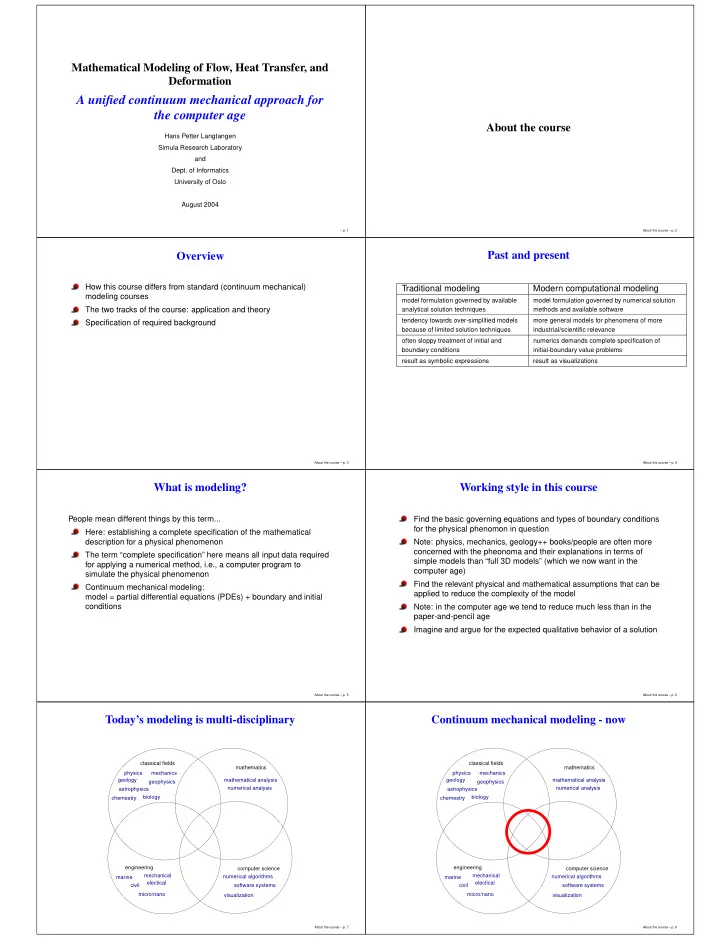

Mathematical Modeling of Flow, Heat Transfer, and Deformation A unified continuum mechanical approach for the computer age About the course Hans Petter Langtangen Simula Research Laboratory and Dept. of Informatics University of Oslo August 2004 – p. 1 About the course – p. 2 Past and present Overview How this course differs from standard (continuum mechanical) Traditional modeling Modern computational modeling modeling courses model formulation governed by available model formulation governed by numerical solution The two tracks of the course: application and theory analytical solution techniques methods and available software tendency towards over-simplified models more general models for phenomena of more Specification of required background because of limited solution techniques industrial/scientific relevance often sloppy treatment of initial and numerics demands complete specification of boundary conditions initial-boundary value problems result as symbolic expressions result as visualizations About the course – p. 3 About the course – p. 4 What is modeling? Working style in this course People mean different things by this term... Find the basic governing equations and types of boundary conditions for the physical phenomon in question Here: establishing a complete specification of the mathematical description for a physical phenomenon Note: physics, mechanics, geology++ books/people are often more concerned with the pheonoma and their explanations in terms of The term “complete specification” here means all input data required simple models than “full 3D models” (which we now want in the for applying a numerical method, i.e., a computer program to computer age) simulate the physical phenomenon Find the relevant physical and mathematical assumptions that can be Continuum mechanical modeling: applied to reduce the complexity of the model model = partial differential equations (PDEs) + boundary and initial conditions Note: in the computer age we tend to reduce much less than in the paper-and-pencil age Imagine and argue for the expected qualitative behavior of a solution About the course – p. 5 About the course – p. 6 Today’s modeling is multi-disciplinary Continuum mechanical modeling - now classical fields classical fields mathematics mathematics physics mechanics physics mechanics geology mathematical analysis geology mathematical analysis geophysics geophysics numerical analysis numerical analysis astrophysics astrophysics biology biology chemestry chemestry engineering engineering computer science computer science mechanical mechanical marine numerical algorithms marine numerical algorithms electical electical civil software systems civil software systems micro/nano micro/nano visualization visualization About the course – p. 7 About the course – p. 8
Continuum mechanical modeling - classical What you will learn I have a physical phenomenon I want to simulate... Which program should I use? (i.e., what are the PDEs?) classical fields mathematics What is the complete specification of input data, i.e., boundary and mathematical analysis mechanics initial conditions, coefficients in the PDEs etc. in my problem? Is the solution I get reasonable? Am I using the program correctly? (i.e., can I reproduce known solutions?) physics How do I debug a simulation with obviously wrong results? (i.e., how can I simplify and control?) engineering mechanical marine civil About the course – p. 9 About the course – p. 10 Modeling implies approximation Course: track (1) “All models are wrong, but some models are useful” (George The concept of stress E. P . Box) Jump start: adapting the general Models are useful even if the quantiative results are ridiculous, as heat transfer equation long as the qualitative effects give insight viscous fluid flow equation The modeling approximation highly influences the choice of elasticity equation numerical approximations (i.e. methods) to various practical problems Approximation in the computer age differs from classical Formulation of (initial-) boundary value problems approximations Emphasis on solving practical problems About the course – p. 11 About the course – p. 12 Prerequisites Course: track (2) Required background: (Euler/Lagrange description, strain) broad experience with calculus, Mass, momentum, and energy balance mathematical modeling of physical systems, Constitute laws: interest in mathematics as a tool Newtonian fluids, generalized Newtonian fluids, linear elasticity, Advantageous background: elasto-visco-plasticity, heat conduction etc. introductory courses on fluid mechanics, General models: 3D elasticity, Navier-Stokes, heat familiarity with stress and strain convection-diffusion Simplified models (potential flow, torsion, beams, gasdynamics, etc) Coupled models: flow, deformation and heat transfer About the course – p. 13 About the course – p. 14 Focus What we do not treat Physical phenomenon → PDE model Advanced continuum mechanics in the classical sense (go to the books!) Generic PDEs with diverse application areas The micro-physical basis of constitutive laws Derive (new) PDE models from basic principles The (difficult) mathematics of constitutive laws Reduce models (i.e. remove terms) Classical solution methods (“local tricks”) of certain continuum Formulate with computer in mind mechanical PDEs See visualizations of numerical solutions Solve and study simple problems analytically About the course – p. 15 About the course – p. 16
Recommend
More recommend